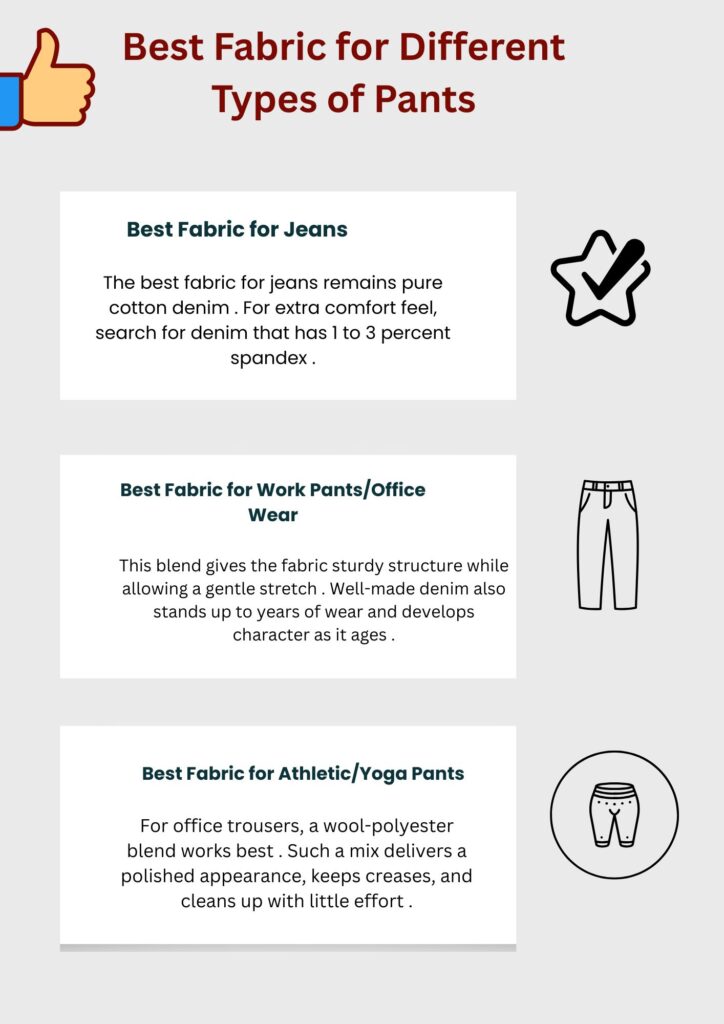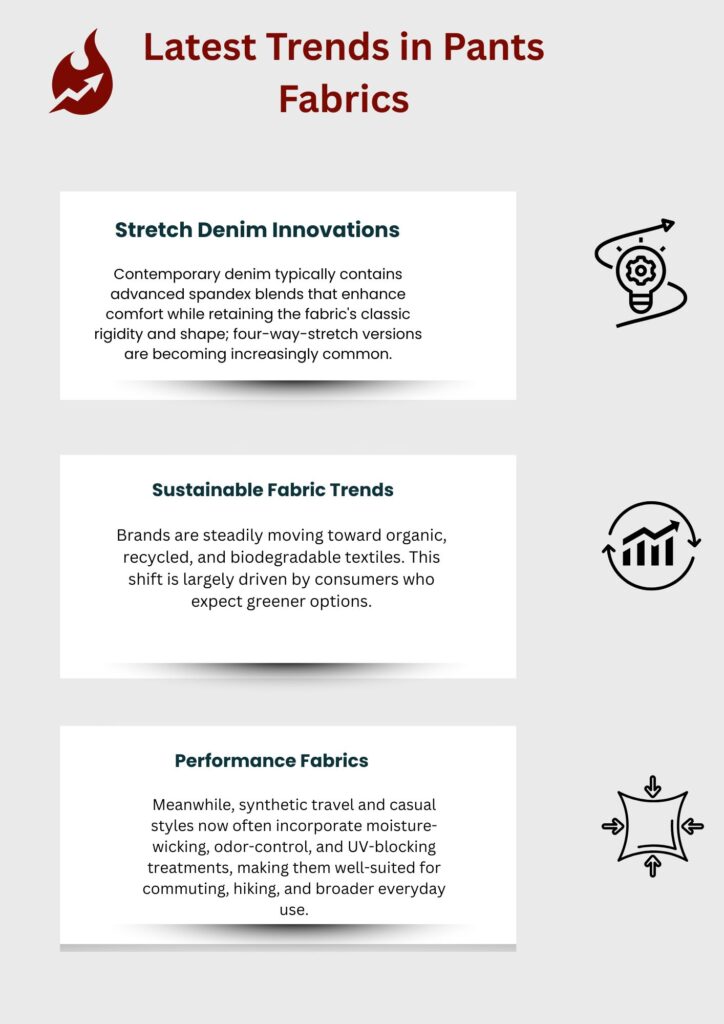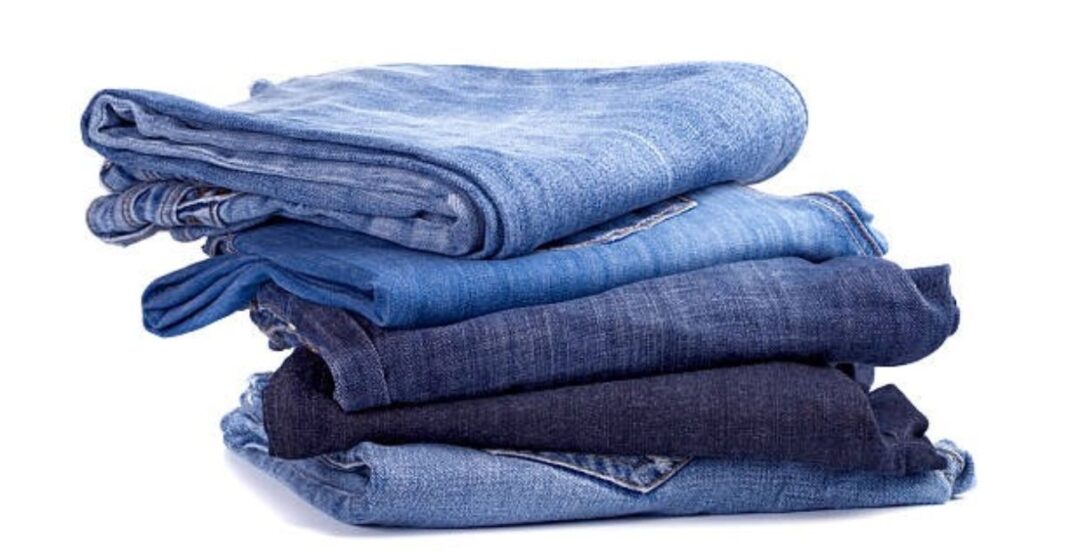Introduction
When the search for the perfect pair of trousers begins, the cut is always tempting to focus on first-yet the cloth deserves equal, if not greater, attention. Fabric dictates every wear experience: how soft the feel against bare skin, how well the weave holds shape after hours of sitting, and even how resilient the garment stays through countless wash cycles. In effect, comfort, longevity, and versatile suitability rise and fall on that single textial choice.Pants fabric material
Every fabric offers its own set of strengths and limitations, responding to climate and occasion in different ways. A lightweight cotton linen mix keeps air flowing on muggy afternoons, while a twill blended with spandex lends the firmness travellers appreciate when packing sits upright for days. Formal events welcome fine woven wool whose sheen balances poise with season-round warmth. Knowing these traits arms the shopper with the confidence to match each situations need rather than rely on fleeting trend .
Why Fabric Choice Matters for Pants
The fabric you choose for pants influences everything from their lifespan to the basic comfort you experience while wearing them. Soft, breathable materials soften long days; sturdy blends keep garments intact when the schedule gets demanding.
Fabric also guides style. Wool trousers exude formality that cotton chinos cannot match. Weight, drape, and elasticity affect how the pants follow your movements. Whether you lean toward looks or utility, the underlying cloth is the true silent partner in every outfit.
How Different Fabrics Affect Comfort, Durability, and Style
Comfort, durability, and style serve as the cornerstones of a reliable pair of trousers. The material from which the pants are cut plays a crucial role in each element
Comfort reaches its highest level with breathable fabrics such as cotton or linen, which naturally regulate heat and moisture. Garments blended with a touch of elastane or similar stretch fibers add significant ease when bending, walking, or sitting.
Durability tends to accompany tougher weaves and synthetic blends; polyester, heavy denim, and classic twill resist fraying, fading, and the daily abrasions of life.
Style is subtly shaped by texture and drape: smooth worsted wool or flowing rayon convey a refined appearance, while ridged corduroy instantly suggests a casual, retro attitude.
Recognizing these distinctive traits equips shoppers to select trousers that truly meet their needs.
Most Common Types of Pants Fabrics
Let us review todays most popular pant fabrics, each of which has clear, consumer-driven advantages
Cotton – Breathable and Versatile
Cotton continues to set the benchmark for comfort, a fact shoppers appreciate. Its softness and natural breathability slip easily into casual cuts, from chinos and admissions to classic denim.
The fibre wicks moisture, tempers heat, and always feels good next to the skin, whether worn on a summers afternoon or a mild winter morning. To boost stretch, longevity, and wrinkle control, makers often pair cotton with modest amounts of spandex, polyester, or nylon. Cotton denim remains the backbone of everyday jeans; brushed variants now anchor loungewear and relaxed chinos
Polyester – Durable and Moisture-Wicking
Polyester is strong and fights shrinking, wrinkles, and wear almost better than any other everyday fabric. Because of these qualities, it shows up in most athletic shorts and travel-friendly pants.
The synthetic fibers pull moisture away from the skin, so workouts feel drier and cooler. Youll see polyester mixes in joggers, hiking bottoms, school uniforms-even work gear.Pants fabric material also low maintenance and dries in a flash.
Wool – Warm and Classic
Wool, by contrast, is a step up and often reserved for dress pants or winter pieces. The natural fibers trap warmth without adding bulk, so cold days seem a little friendlier.
Thats why youll find wool in sharp-looking suits as well as casual chinos. The cloth also fights odors and wrinkles, though most pieces appreciate a gentle dry-clean now and then.
Linen Lightweight and Breathable
Linen comes from the flax plant, making it a top pick for summer pants. Its breathability lets air flow freely, and the slight texture feels nice with seaside or laid-back outfits.
Yes, it creases at the slightest touch, but many people actually like that lived-in look.Pants fabric material on sweltering days, linen keeps you cool and still looks good, whether you’re at a café or on a getaway.
Denim – Rugged and Iconic
Denim, a durable woven cotton, is the fabric we usually associate with jeans. Few materials are as globally recognizable; denim practically has its own passport.
You can buy it either with a little stretch or in a pure, non-stretch weave. The stretchy kind contains elastane for a soft hug, while the old-school style stays rigid and structured. People reach for denim because it shrugs off wear and adapts to nearly any occasion.
Spandex/Elastane – Stretchy and Flexible
Spandex-elastane or Lycra-is woven into many fabrics so they stretch and bounce back. That tiny blend is what makes yoga pants, tights, and soft activewear feel so forgiving.
Adding spandex lets the fabric flex without pinching, so every stride or squat is easier. Youll also find the blend in denim, travel slacks, and even team uniforms for that same comfort.
Nylon – Lightweight and Water-Resistant
Nylon, a light yet tough synthetic, laughs at water, mildew, and scuffs. Its the go-to fiber whenever pants will spend long days hiking, traveling, or under open skies.
Because nylon dries fast, makers usually pair it with cotton, mesh, or a hint of spandex for extra breathability. That recipes strength and quick-dry finish suit anyone chasing adventure.
Rayon/Viscose – Soft and Drapey
Rayon, frequently labeled viscose, comes from plant cellulose and sits between natural and man made fibers. Its surface feels cool and silky, making garments drape beautifully around the body.
You’ll find rayon in flowy blouses, semi-formal skirts, and wide-leg summer trousers where that luxe hang matters most. Just remember-rayon loves gentle washing, low heat, and patience; ignore those steps and it may shrink or lose shape.
Twill – Durable and Structured
Twill isn’t a fiber but a weaving style, usually shown in sturdy cotton, polyester, or blends. The result is a slanted, ribbed pattern that gives the fabric serious strength while still feeling soft enough for everyday wear.
Because of its resilience, twill appears in chinos, work bottoms, school uniforms, and even some technical gear..Pants fabric material it resists wrinkles, stains, and sagging better than smoother weaves, so pieces stay crisp through many cycles.
Best Fabric for Different Types of Pants
Lets match the ideal pants fabric material. with specific use cases based on long-tail search keywords .

Best Fabric for Jeans
The best fabric for jeans remains pure cotton denim . For extra comfort feel, search for denim that has 1 to 3 percent spandex .
Best Fabric for Work Pants/Office Wear
This blend gives the bottoms sturdy structure while allowing a gentle stretch.Pants fabric material well-made denim also stands up to years of wear and develops character as it ages .
Best Fabric for Athletic/Yoga Pants
For office trousers, a wool-polyester blend works best.Pants fabric material Such a mix delivers a polished appearance, keeps creases, and cleans up with little effort .
Best Fabric for Travel Pants
Nylon-polyester blends are a solid bet for travel bags. They stay light, shrug off water, and dry in a flash.
Seek out stretchy, wrinkle-proof options for even smoother road days.
Best Fabric for Summer/Winter Pants
In summer, stick with breathable linen or featherweight cotton. In winter, reach for warm wool, soft corduroy, or thermal-lined cloth.
Either route keeps you comfy for the weather and still looks sharp.
How to Choose the Right Pants Fabric
Picking the best fabric for your pants really comes down to what you do every day and how the weather behaves. Keep these tips in mind:
Comfort (Breathability, Softness)
For steamy days, reach for light, breathable stuff such as cotton or linen; a hint of spandex in the blend adds stretch when you bend or sit.
Durability (Abrasion Resistance, Longevity)
When long-lasting toughness matters, choose heavy denim, sturdy twill, or synthetic polyester; each shrugs off scuffs and helps the seams stay intact.
Care & Maintenance (Machine Wash vs. Dry Clean)
Casual fabrics like cotton and polyester wash easily in the machine. Softer kinds such as wool or rayon usually need dry cleaning or a gentle hand wash.
Climate Suitability (Hot vs. Cold Weather)
Linen and cotton work well in hot weather, while wool and corduroy keep you toasty when temps drop. Pick your cloth based on the season where you live.
Sustainable & Eco-Friendly Pants Fabrics
Sustainability is front-and-center in fashion talk nowadays. Because of that, many shoppers now choose pants made from greener, earth-friendly materials.
Organic Cotton
Organically grown cotton avoids synthetic pesticides and fertilizers, leaving a smaller ecological footprint while remaining soft enough for sensitive skin.
Hemp
Hemp matures in a matter of months, uses little water, and fends off most pests on its own, producing a durable yet laid-back fabric for everyday trousers.
Bamboo Fabric
Bamboo fibres breathe freely and stay cool, while their natural antimicrobial properties cut body odour, so the material works well as a comfort liner in travel or active pants.
Recycled Polyester
Crafted from reclaimed plastic bottles, this variation of polyester minimizes landfill buildup while consuming less energy in production.
Tencel/Lyocell
Sourced from sustainably harvested wood pulp, Tencel is both biodegradable and luxuriously soft, making it an excellent choice for dress trousers and smart-casual outfits.
Pros and Cons of Different Pants Fabrics
For a side-by-side look at these materials, see the comparison table below:
| Fabric | Pros | Cons |
| Cotton | Breathable, soft | Wrinkles easily |
| Polyester | Durable, wrinkle-resistant | Less breathable |
| Wool | Warm, elegant | Requires dry cleaning |
| Denim | Cool, lightweight | Prone to wrinkling |
| Spandex | Durable, stylish | Can be stiff without elastane |
| Nylon | Stretchy, flexible | Not breathable on its own |
| Rayon | Water-resistant, strong | Not eco-friendly |
| Twill | Soft, smooth | Shrinks easily |
| Corduroy | Strong, resists wrinkles | May be heavier than plain weaves |
Latest Trends in Pants Fabrics

Designers and textile engineers consistently experiment with fabrics, resulting in a growing variety of performance features in everyday trousers.
Stretch Denim Innovations
Contemporary denim typically contains advanced spandex blends that enhance comfort while retaining the fabric’s classic rigidity and shape; four-way-stretch versions are becoming increasingly common.
Performance Fabrics
Meanwhile, synthetic travel and casual styles now often incorporate moisture-wicking, odor-control, and UV-blocking treatments, making them well-suited for commuting, hiking, and broader everyday use.
Sustainable Fabric Trends
Brands are steadily moving toward organic, recycled, and biodegradable textiles. This shift is largely driven by consumers who expect greener options.
How to Care for Different Pants Fabrics
Routine, gentle care boosts the lifespan of pants and keeps the fabric looking fresh.
Washing & Drying Tips
- Always wash cotton, rayon, and blended materials in cold water.
- Wool and other delicate pieces should go inside a mesh bag or be sent to the dry cleaner.
- With performance fabrics such as polyester and spandex, skip the fabric softener altogether.
Avoiding Shrinkage & Fading
- Air-dry your pants whenever you can to help stop them from shrinking.
- Before washing, turn the pants inside out; doing so protects the color and slows fading.
Conclusion
Choosing pants is not only a matter of looks, it takes thinking of breathability, comfort and ease of wearing along with how long it’ll last.. Depending on the season, you may need breathable cotton shorts during summer, stretchy spandex for workouts, or durable denim for everyday activities. Each fabric serves a purpose that can complement your schedule, weather, and style.
Now available as alternatives are organic cotton, hemp and Tencel that provide comfort along with sustainable materials which are kind on the environment. With so many eco-friendly options available now, there hasn’t been a time better than this to find the right pair of pants!
Every fabric has its good and bad sides, but knowing their differences makes it easy to choose a pair of pants that meet your expectations, daily needs, and values. When it comes to looking for high quality pants, their fabric sets the standard of their value, so choose wisely!
FAQ
Denim, polyester, and twill rank among the toughest materials you can choose.
Moisture-wicking blends such as polyester or bamboo handle perspiration the best.
Look for a tight weave, minimal fuzz, even color, and a pleasant feel, whether smooth or soft.


